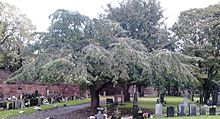Ulmus glabra 'Horizontalis'
| Ulmus glabra | |
|---|---|

'Horizontalis', Seafield Cemetery, Edinburgh
|
|
| Cultivar | 'Horizontalis' |
| Origin | Perth, Scotland |
The Wych Elm cultivar Ulmus glabra 'Horizontalis', commonly known as the Weeping Wych Elm or Horizontal Elm, was discovered in a Perth nursery circa 1816. The tree was originally identified as 'Pendula' by Loddiges (London), in his catalogue of 1836, a name adopted by Loudon two years later in Arboretum et Fruticetum Britannicum, 3: 1398, 1838, but later sunk as a synonym for 'Horizontalis'.
'Horizontalis' has branches that extend out horizontally with weeping branchlets. It is usually grafted onto a tall understock of Ulmus glabra to effectively display its weeping habit. The tree can eventually grow to a height of 20 metres with a similar spread. It can be distinguished from the related Camperdown Elm by its more spreading and flattened canopy and much larger mature size, although its shape does vary widely, as noted by Loudon: "A beautiful...tree generally growing to one side, spreading its branches out in a fan-like manner...sometimes horizontally and at other times almost perpendicularly downwards so that the head of the tree exhibits great variety of shape".
Dried short-shoot 'Horizontalis' leaves (August)
'Horizontalis', St Philip's Cathedral churchyard, Birmingham
Top of 'Horizontalis' in Royal Pavilion Gardens, Brighton, UK, in 1988
An expert graft, for even, horizontal growth
'Horizontalis' is not known to be any less susceptible to Dutch elm disease than the species.
The cultivar was found in a bed of seedling in the Perth Nursery, the plant was purchased by of Hamburg, Germany who then distributed it. Specimens supplied by the Späth nursery to the Royal Botanic Garden Edinburgh in 1902 as U. montana 'Horizontalis' may survive in Edinburgh as it was the practice of the Garden to distribute trees about the city (viz. the Wentworth Elm); the current list of Living Accessions held in the Garden per se does not list the plant.
...
Wikipedia
